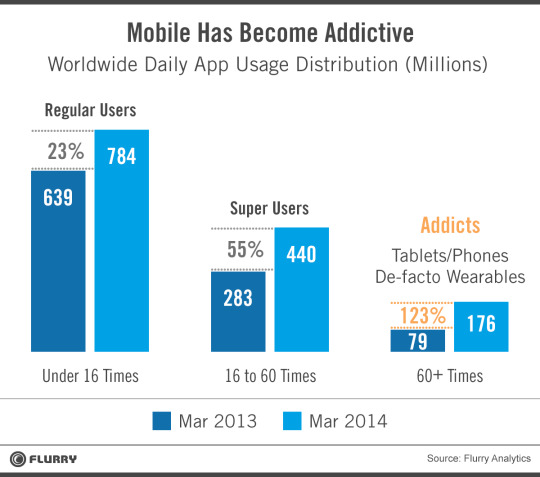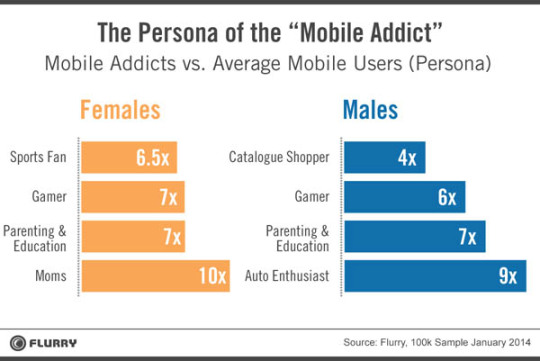In May of 2013, KPCB’s Partner and world-renowned analyst Mary Meeker shared her latest Internet Trends Report. In that report, Ms. Meeker shared an interesting stat: “The average mobile consumer checks their device 150 times a day”. That number raised a few eyebrows and led many analysts to question the difference between existing smartphones and highly anticipated “Wearables”. In this report, we have used data from Flurry Analytics to analyze the behavior of consumers that heavily use their smartphones or tablets, a segment we refer to as the “Mobile Addict”.
We have defined a “Mobile Addict” as a consumer that launches apps more than 60 times per day. Looking at data Flurry sees from 500,000 apps across 1.3B devices as of March 2014, we know that on average, a consumer launches apps 10 times per day. So we have defined a “Mobile Addict” as someone who launches apps 6 times more per day than the average.
Mobile Addicts Are Multiplying
The chart below shows the year-over-year growth in usage, across all segments of mobile app users. The Mobile Addict segment is growing the fastest, posting 123% growth between 2013 and 2014. In March of 2014, there were 176 million Mobile Addicts, up from 79 million in March of 2013. That is astonishing growth in a single year. This compares to 55% growth for a category we’re calling Super Users and 23% for Regular Users, who launch apps 16 times or less per day.

Most Addicted? Teens, College Students and Middle-Age Parents
We dug deeper into the Mobile Addicts segment to better understand that audience.
Mobile Addicts were 52% female and 48% male, compared to 48% female and 52% male for an average mobile users. That means females over-index 8% compared to the average mobile user. The 8% number appears small, but it is significant: In the total Mobile Addict population of 176 million, it means that there are 15 million more female Mobile Addicts than male Mobile Addicts.

Now looking at age, the Mobile Addict segment over indexed on the 13-17 (Teens), 18-24 (College Students) and 35-54 (Middle Aged) age segments. In fact, Middle Aged consumers constituted 28% of Mobile Addicts, but only constituted 20% of the average mobile consumer. The Addict segment under indexed on 25-34 (adults) and 55+ (seniors).

The analysis gets even more interesting when you dive into the differences among Flurry Personas.
On the female side, the following Personas over-indexed as Mobile Addicts: Moms, Parenting & Education, Gamers and Sports Fans, in that order.
For Males, the following Personas over-indexed as Mobile Addicts: Auto Enthusiasts, Parenting and Education, Gamers and Catalogue Shoppers.
The “Over-Index” is shown in the chart below. It refers to the division of the percentage reach of that Persona in the Mobile Addict segment compared to the percentage reach of that Persona for the average mobile consumer. For example, in the male Mobile Addict segment, Auto Enthusiasts are 26% of the total, while for the average male mobile consumer Auto Enthusiasts are just 3% of total. In other words, male Mobile Addicts are much more likely to be Auto Enthusiasts than non-Addicts.

Looking at the three charts above, we are starting to form a relatively clear picture of a Mobile Addict. Teens, College Students (skewing females) and Middle Age Parents. We were not surprised by teens being part of the group. Their youth coincided with the mobile revolution – they are not just accustomed to mobile, they expect their mobile device to handle nearly every type of task and communication. The same is true for college students who are noticeably avid users of messaging and gaming apps. We were also comfortable with young adults under-indexing. They have just entered the workforce, are predominantly single and are likely out and about more often than older and younger segments.
What surprised us most was the over-indexing of the middle-age segment and by a margin that beats that of teens. But when we inspected the Personas of that segment and their app usage, we came to the conclusion that these middle-aged consumers are probably part of a family and their devices are likely shared among multiple family members, including their children. Males and females in the Middle Age segment both over-indexed on parenting and education. Males over indexed as Catalogue Shoppers and females over indexed on Sports. The picture we formed is a family of four, with two phones, one tablet, and all three devices shared by the family for education, entertainment and more utilitarian functions as well.
A Sneak-Peek into the Wearable Early-Adopter
Mobile Addicts launch apps over 60 times per day, making them consumers that are effectively wearing their devices. This analysis of the Mobile Addict should give us a sneak preview into the make-up of early-adopters of Wearables, and what types of apps and experiences will resonate with them. To date, many applications for Wearables have focused on fitness and health, but thinking about what’s next, developers should think about the other experiences that will delight the people who need to be connected all the time. This includes Teens, College Students and Middle-Aged parents who are interested gaming, autos, sports and shopping, and who may have a constant need to entertain or educate their children. After all, the people who we consider “Mobile Addicts” are already essentially wearing their devices 24/7/365.
Note: You can read more mobile trends and data from Simon Khalaf’s “The Age of Living Mobile” presentation at Source14 here.